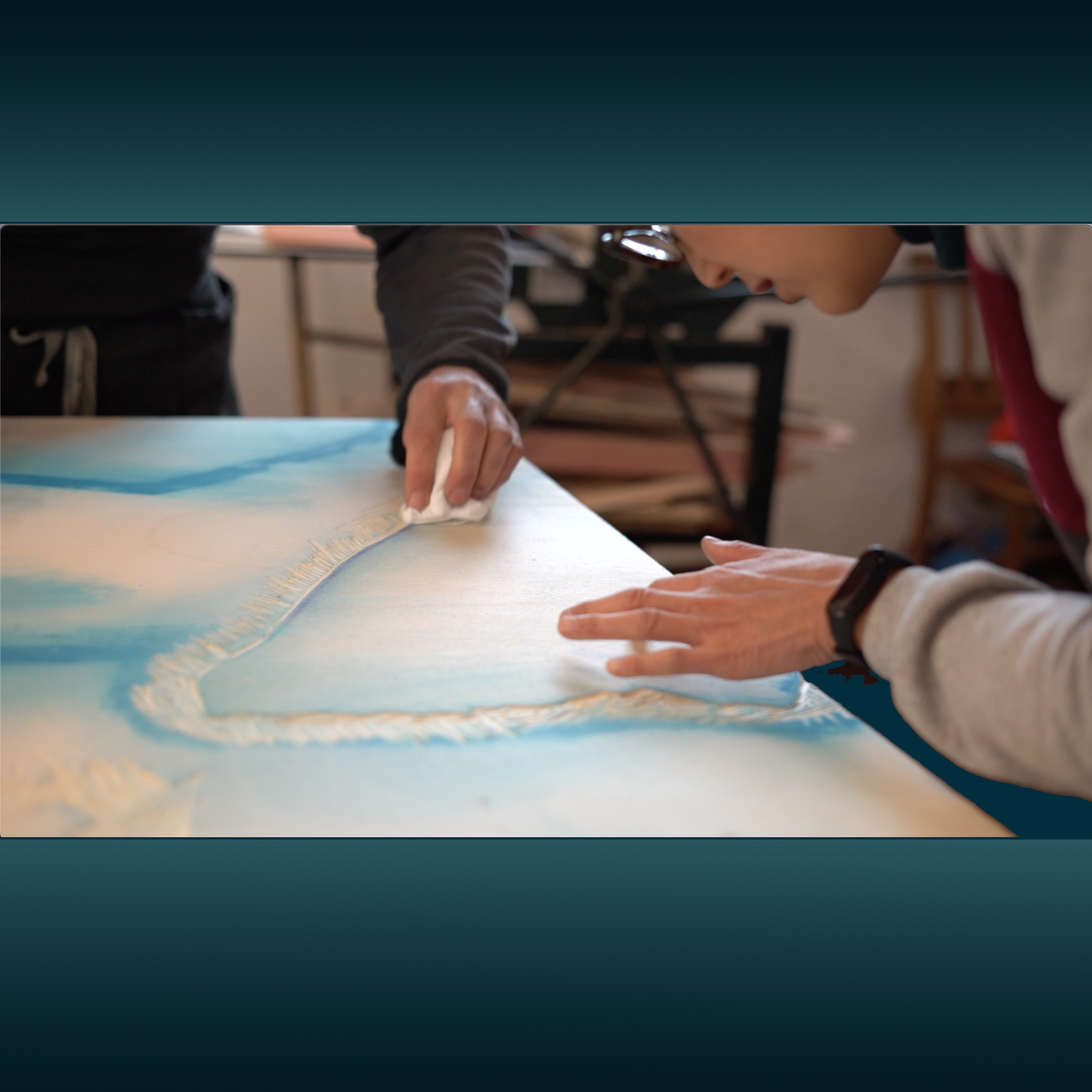Hartland Hanga
Capturing creative communication of tacit knowledge in printmaking
DOI:
https://doi.org/10.7577/formakademisk.5449Emneord (Nøkkelord):
Printmaking, Tacit Knowledge, Embodied learning, woodblock printing, practice-led researchSammendrag
From October 2021 to July 2022 the author, Wuon-Gean Ho, was invited to work with a printmaking collective called Pine Feroda. Based in the UK, Pine Feroda create impressive large-scale woodblock prints of nature. Using a practice-led approach, the author developed an entirely novel printmaking technique which she named Hartland Hanga. Making audio-visual recordings of the artists working together captured the transmission of tacit knowledge as it emerged in real time. Using elements of conversation analysis from ethnography revealed how this group spoke to each other. The artists used creative strategies such as new phrases, verbal metaphors and gestural analogies to communicate elements of tacit knowledge. It is postulated that humour and creative communication might help the transmission and embedding of tacit knowledge between artists.
Referanser
Bateson, G., & Mead, M. (1942). Balinese Character—A Photographic Analysis. New York Academy of Sciences. https://monoskop.org/images/8/8d/Bateson_Gregory_Mead_Margaret_Balinese_Character_A_Photographic_Analysis.pdf
Beilock, S. L., Lyons, I. M., Mattarella-Micke, A., Nusbaum, H. C., & Small, S. L. (2008). Sports experience changes the neural processing of action language. Proceedings of the National Academy of Sciences, 105(36), 13269–13273. https://doi.org/10.1073/pnas.0803424105
Berkovich-Ohana, A., Dor-Ziderman, Y., Trautwein, F.-M., Schweitzer, Y., Nave, O., Fulder, S., & Ataria, Y. (2020). The Hitchhiker’s Guide to Neurophenomenology – The Case of Studying Self Boundaries With Meditators. Frontiers in Psychology, 11, 1680. https://doi.org/10.3389/fpsyg.2020.01680
Davie, W. (2022, July 29). The Romance of a New Medium: Helen Frankenthaler and the Art of Collaboration. https://gagosian.com/quarterly/2022/07/29/essay-romance-of-a-new-medium-helen-frankenthaler-and-the-art-of-collaboration/
Diamond, A. (2013). Executive Functions. Annual Review of Psychology, 64(1), 135–168. https://doi.org/10.1146/annurev-psych-113011-143750
Fortun, K., George E., M., James, C., Mary Louise, P., Michael M. J., F., Paul, R., Renato, R., & Stephen A., T. (2020). Writing Culture (J. Clifford & G. E. Marcus, Eds.; 25th Anniversary Edition, Reprint 2020). University of California Press.
Garfinkel, H. (1984). Studies in ethnomethodology. Polity Press.
Geertz, C. (1973). The Interpretation of Cultures, Selected Essays. Fontana Press.
Gentner, D., & Smith, L. A. (2013). Analogical Learning and Reasoning. Oxford University Press. https://doi.org/10.1093/oxfordhb/9780195376746.013.0042
González-Martínez, E., & Mlynář, J. (2019). Practical trust. Social Science Information, 58(4), 608–630. https://doi.org/10.1177/0539018419890565
Green, J. L., Baker, W. D., Chian, M. M., Vanderhoof, C., Hooper, L., Kelly, G. J., Skukauskaite, A., & Kalainoff, M. Z. (2020). Studying the Over-Time Construction of Knowledge in Educational Settings: A Microethnographic Discourse Analysis Approach. Review of Research in Education, 44(1), 161–194. https://doi.org/10.3102/0091732X20903121
Heath, C., Hindmarsh, J., & Luff, P. (2010). Video in qualitative research: Analysing social interaction in everyday life. SAGE. https://doi.org/10.4135/9781526435385
Ingold, T. (2015). The Life of Lines. Routledge.
Kontra, C., Goldin-Meadow, S., & Beilock, S. L. (2012). Embodied Learning Across the Life Span. Topics in Cognitive Science, 4(4), 731–739. https://doi.org/10.1111/j.1756-8765.2012.01221.x
Korn, P. (2017). Why We Make Things and Why it Matters – The Education of a Craftsman. Random House.
Kosma, M. (2023). Phenomenological Body Schema as Motor Habit in Skill Acquisition – Intentionality is in Action. Athens Journal of Sports, 10(2), 83–94. https://doi.org/10.30958/ajspo.10-2-2
Merleau-Ponty, M. (1964). The Primacy of Perception (J. M. Edie (Ed.)). Northwestern University Press.
Mukerji, C. (2014). The cultural power of tacit knowledge: Inarticulacy and Bourdieu’s habitus. American Journal of Cultural Sociology, 2, 348–375. https://doi.org/10.1057/ajcs.2014.8
Peng, M. Y.-P., Feng, Y., Zhao, X., & Chong, W. (2021). Use of Knowledge Transfer Theory to Improve Learning Outcomes of Cognitive and Non-cognitive Skills of University Students: Evidence From Taiwan. Frontiers in Psychology, 12, 583722. https://doi.org/10.3389/fpsyg.2021.583722
Psathas, G. (Ed.). (1979). Everyday language: Studies in ethnomethodology. Irvington Publishers/ Halsted Press.
Pye, D. (2007). The Nature and Art of Workmanship. Herbert Press.
Saragih, H. (2019). Co-creation experiences in the music business: A systematic literature review. Journal of Management Development, 38(6), 464–483. https://doi.org/10.1108/JMD-11-2018-0339
Sennett, R. (2008). The craftsman. Yale University Press.
Sidnell, J., & Stivers, T. (Eds.). (2013). The handbook of conversation analysis. Wiley-Blackwell. https://doi.org/10.1002/9781118325001
Smith, E. A. (2001). The role of tacit and explicit knowledge in the workplace. Journal of Knowledge Management, 5(4), 311–321. https://doi.org/10.1108/13673270110411733
Wenger-Trayner, E., & Wenger-Trayner, B. (2015). An introduction to communities of practice: A brief overview of the concept and its uses. https://www.wenger-trayner.com/introduction-to-communities-of-practice

Nedlastinger
Publisert
Hvordan referere
Utgave
Seksjon
Lisens
Opphavsrett 2023 Wuon-Gean Ho

Dette verket er lisensiert under Creative Commons Attribution-NoDerivatives 4.0 International License.
- Forfatteren(e) beholder sin opphavs- og kopieringsrett til eget manuskript, men gir tidsskriftet varig rett til 1) å fremføre manuskriptet for offentligheten i den opprinnelig publiserte digitale form, og 2) å registreres og siteres som første publisering av manuskriptet.
- Forfatteren må selv forvalte sine økonomiske kopieringsrettigheter overfor eventuell tredjepart.
- Tidsskriftet gir ingen økonomisk eller annen kompensasjon for innsendte bidrag, medmindre det er gjort særskilt avtale om dette med forfatteren(e).
- Tidsskriftet plikter å arkivere manuskriptet (inklusive metadata) i den opprinnelig publiserte digitale form, i minst ett dertil egnet åpent tilgjengelig langtidsarkiv for digitalt materiell, som for eksempel i de norske universitetenes institusjonsarkiv innen rammen av NORA-samarbeidet.
Verket vil bli publisert OpenAccess med en Creative Commons 4.0-lisens som tillater alle å lese, dele og tilpasse innholdet, også kommersielt, under lisensvilkårene:
Dette verket må tilskrives/ krediteres på riktig måte, en lenke må gis til CC-BY 4.0-lisensen, og endringer som er gjort må angis på en rimelig måte, men ikke på noen måte som antyder at lisensgiveren støtter deg eller din bruk.



